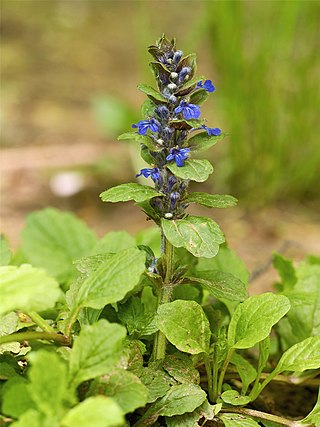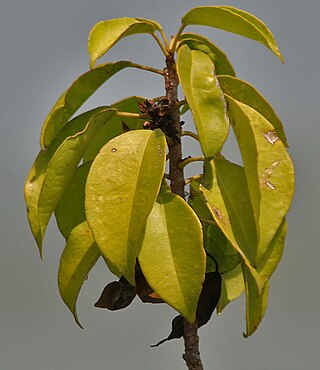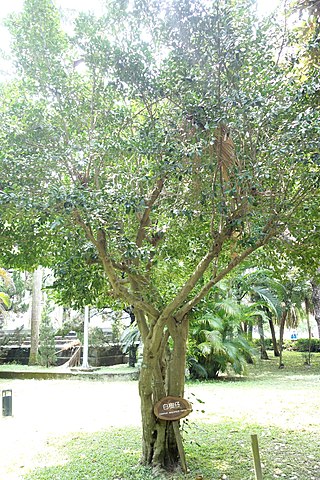
Cymbopogon, also known as lemongrass, barbed wire grass, silky heads, oily heads, Cochin grass, Malabar grass, citronella grass or fever grass, is a genus of Asian, African, Australian, and tropical island plants in the grass family. Some species are commonly cultivated as culinary and medicinal herbs because of their scent, resembling that of lemons . The name cymbopogon derives from the Greek words kymbe and pogon "which mean [that] in most species, the hairy spikelets project from boat-shaped spathes." Lemongrass and its oil are believed to possess therapeutic properties.

Ajuga, also known as bugleweed, ground pine, carpet bugle, or just bugle, is a genus of flowering plants in the Ajugeae tribe of the mint family Lamiaceae. There are over 60 species of annual or perennial, mostly herbaceous plants. They are native to Europe, Asia, Africa, and Australia.

Mallotus is a genus of the spurge family Euphorbiaceae first described as a genus in 1790. Two species are found in tropical Africa and Madagascar. All the other species are found in East Asia, the Indian Subcontinent, Southeast Asia, eastern Australia, and certain islands of the western Pacific. The genus has about 150 species of dioecious trees or shrubs.

Tabernaemontana is a genus of flowering plants in the family Apocynaceae. It has a pan-tropical distribution, found in Asia, Africa, Australia, North America, South America, and a wide assortment of oceanic islands. These plants are evergreen shrubs and small trees growing to 1–15 m tall. The leaves are opposite, 3–25 cm long, with milky sap; hence it is one of the diverse plant genera commonly called "milkwood". The flowers are fragrant, white, 1–5 cm in diameter.

Excoecaria is a plant genus of the family Euphorbiaceae, formally described by Linnaeus in 1759. The genus is native to the Old World Tropics.

Suregada is a plant genus of the family Euphorbiaceae, first described as a genus in 1803. It is native to tropical and subtropical regions of Africa, the Indian Subcontinent, China, Southeast Asia, Australia, and certain oceanic islands.

Bridelia is a plant genus of the family Phyllanthaceae first described as a genus in 1806. It is widespread across Africa, Australia, southern Asia, and various islands of the Indian and Pacific Oceans.

Drypetes is a plant genus of the family Putranjivaceae, in the order Malpighiales.

Najas, the water-nymphs or naiads, is a genus of aquatic plants. It is cosmopolitan in distribution, first described for modern science by Linnaeus in 1753. Until 1997, it was rarely placed in the Hydrocharitaceae, and was often taken as constituting the family Najadaceae.

Chionanthus, common name: fringetrees, is a genus of about 150 species of flowering plants in the family Oleaceae.

Dactyloctenium is a genus of Asian, African, and Australian plants in the grass family. There are about 13 species in the genus in the world, in which 3 are known to occur in India. A common name for the plants is crowfoot grasses.

Gastrodia, commonly known as potato orchids or as 天麻属 , is a genus of terrestrial leafless orchids in the family Orchidaceae, about ninety of which have been described. Orchids in this genus have fleshy, upright stems and small to medium-sized resupinate flowers with narrow sepals and petals. They are native to Asia, Australia, New Zealand, central Africa, and various islands of the Indian and Pacific Oceans.

Medinilla magnifica, the showy medinilla or rose grape, is a species of epiphytic flowering plant, of the family Melastomataceae, native to the Philippines. Various cultivars and hybrids of this species, genus and family are well-known and have grown to be popular with plant collectors; the species Medinilla speciosa is equally as popular.

Isachne is a widespread genus of tropical and subtropical plants in the grass family, found in Asia, Africa, Australia, the Americas, and various oceanic islands. They may be known generally as bloodgrasses.

Murdannia is a genus of annual or perennial monocotyledonous flowering plants in the family Commelinaceae.

Medinilla speciosa is a perennial epiphytic plant in the genus Medinilla of the family Melastomataceae.

Platostoma is a genus of flowering plants in the mint family, Lamiaceae, first described as a genus in 1818. It is native to tropical parts of Africa, southern Asia, Papuasia, and Australia. Mesona and Acrocephalus has been known as its synonyms.

Medinilla sedifolia is a perennial plant of the family Melastomataceae that grows primarily in Madagascar, but is occasionally used as a terrarium plant, an epiphyte mounting, or in hanging pots. It is small for the genus, growing only 75–150 mm (3–6 in) tall. The waxy evergreen leaves grow on a trailing stem. It flowers twice per year, the five petaled flowers are magenta, waxy to the touch, and about 15 mm wide when fully grown.
Medinilla theresae is an endemic species of flowering evergreen shrub or liana in the family Melastomataceae, occurring on ultramafic soils on the dwarf forests of Mt. Redondo, Dinagat Island at 700-840 elevation, and at Mt. Hamiguitan, Philippines at growing at 900 m elevation on the edges of upper montane forest, which reaches up to the 'mossy-pygmy' forest with elevation ranges of 1160−1200 m and 1460−1600 m elevation, respectively. This terrestrial, cauliflorous shrub can grow erect at 1.5 m high. The species whorled leaves, flowers which are 4-merous, and the pendulous inflorescences likened the species to M. pendula. However, it differed from the latter on distinct secondary veins on the leaves adaxial surface, the inflorescences which are cauline or axillary, and its straight anthers.

Grona is a genus in the flowering plant family Fabaceae. Its native range is worldwide tropics and subtropics.




















